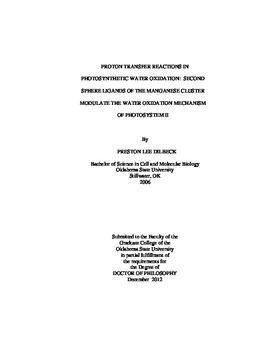| dc.contributor.advisor | Burnap, Robert Lord | |
| dc.contributor.author | Dilbeck, Preston Lee | |
| dc.date.accessioned | 2015-06-17T20:05:33Z | |
| dc.date.available | 2015-06-17T20:05:33Z | |
| dc.date.issued | 2012-12 | |
| dc.identifier.uri | https://hdl.handle.net/11244/14801 | |
| dc.description.abstract | Scope and Method of Study: Physiological and Biophysical characterization of point mutations in the D1 subunit of PSII. | |
| dc.description.abstract | Findings and Conclusions: In the D1-D61N mutant, it was possible to resolve a clear lag phase prior to the appearance of O2, indicating formation of an intermediate before onset of O2 formation. The lag phase and the photochemical miss factor were more sensitive to isotope substitution in the mutant indicating that proton efflux in the mutant proceeds via an alternative pathway. The results are discussed in comparison with earlier results obtained from the substitution of CP43-Arg357 with lysine and in regards to hypotheses concerning the nature of the final steps in photosynthetic water oxidation. These considerations lead to the conclusion that proton expulsion during the initial phase of the S3-S0 transition starts with the deprotonation of primary catalytic base, probably CP43-Arg357, followed by efficient proton egress involving the carboxyl group of D1-D61 in a process that constitutes the lag phase immediately prior to O2 formation chemistry. The asparagine, phenylalanine and threonine substitutions to D1-V185 were able to accumulate significant levels of charge separating PSII. Of the three substitutions the phenylalanine substitution was the most severe with a complete inability to evolve oxygen, despite being able to accumulate Photosystem II and to undergo stable charge separations. The threonine substitution had no apparent effect on oxygen evolution other than a 40% reduction in the steady state rate of O2 production compared to type Synechocystis, which can be attributed to that mutants reduced ability to accumulate PSII. The asparagine substitution produced the most complex phenotype. While still able to evolve oxygen, it does so less efficiently than wild type PSII, with a miss factor 4% higher than wild type Synechocystis. The substitution on D1-Val185 with asparagine also decreased the t1/2 of O2 release from thylakoid membranes from 1.2 ms to 10.0 ms and decreased the t1/2 lag phase prior to the onset of O2 release to 2.8 ms. The combination of a long lag period and a decreased rate of O2 release can also be observed in the D1-D61N mutant strains of Synechocystis and in PSII centers in which chloride has been replaced by iodide. | |
| dc.format | application/pdf | |
| dc.language | en_US | |
| dc.rights | Copyright is held by the author who has granted the Oklahoma State University Library the non-exclusive right to share this material in its institutional repository. Contact Digital Library Services at lib-dls@okstate.edu or 405-744-9161 for the permission policy on the use, reproduction or distribution of this material. | |
| dc.title | Proton transfer reactions in photosynthetic water oxidation: Second sphere ligands of the manganese cluster modulate the water oxidation mechanism of Photosystem II | |
| dc.contributor.committeeMember | Hoff, Wouter D. | |
| dc.contributor.committeeMember | Prade, Rolf A. | |
| dc.contributor.committeeMember | Henley, William J. | |
| dc.contributor.committeeMember | Yu, Chang-An | |
| osu.filename | Dilbeck_okstate_0664D_12534.pdf | |
| osu.accesstype | Open Access | |
| dc.type.genre | Dissertation | |
| dc.type.material | Text | |
| dc.subject.keywords | cyanobacteria | |
| dc.subject.keywords | photosynthesis | |
| dc.subject.keywords | photosystem ii | |
| dc.subject.keywords | proton transfer | |
| dc.subject.keywords | water oxidation | |
| thesis.degree.discipline | Microbiology, Cell and Molecular Biology | |
| thesis.degree.grantor | Oklahoma State University | |
